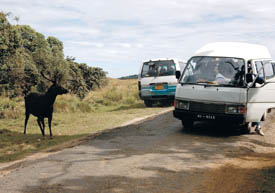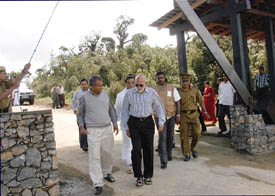|
DAILY NEWS ONLINE |
|
|
|
OTHER EDITIONS |
|
|
|
|
|
|
|
|
|
OTHER LINKS |
|
|
|
|
|
|
  |
New heavenly dimension to Horton Plains
FOR a moment I stood still on the nature trail I was following and watched the thick mist come rolling on. It passed over me and I looked back to see it sailing further on. I reached the World's End and looked over the precipice. The mist was thick and nothing could be seen at the bottom. After a few seconds the mist lifted and the Nonpareil Estate came into view. The other day when we drove in to the park late evening the mist was thick and through the rays of the vehicle lights I saw a group of Sambur silhouetted against this backdrop unmoving but peering at us. The next day I stood at the window of the Mahaeliya Holiday Resort we were occupying watching the mist come rolling in to envelop the entire location on which the bungalow stood. A few minutes later the mist cleared and the road running past the bungalow and the garden came into view. This is the beauty of the Montane Cloud Forest also known as the Horton Plains National Park, my favourite location of exquisite natural beauty where I have always experienced spiritual peace and harmony with the Creator. The recent visit to Horton Plains was organised for us, a group of Environmental Journalists by the Education and Promotion Unit of the Ministry of Environment and Natural Resources. This was to participate at the official opening ceremony of new developments to the park by the Environment and Natural Resources Minister A. H. M. Fowzie. Under the Protected Area Management and Wildlife Conservation Project of the Department of Wildlife Conservation, new facilities to the existing park infrastructure have been built in to make it more popular with visitors both foreign and local. Pattipola entrance Harmonising with the natural beauty of the park is the new Pattipola entrance and the Visitor Centre built at an elevation by a natural pool. A large information board with a picture of riding horsemen states: " As you drive up the road into the park you are following the horseback trail of colonial times. Until the late 1960s when the road was built, the only access to the park was by horse or by hiking. The forest at the entrance is Eucalyptus, planted 50 years ago for timber for railroad sleepers. Though Eucalyptus forests are rich in insects, biodiversity is generally low.
"As you climb the mountain, the forest changes. The Eucalyptus plantation gives way to natural jungle which is all endemic species: plants and animals found nowhere else. Much of the fauna is `relict', those species unchanged over time. They are the ancient species of the mountain - the ones that survived when others didn't. By the time you reach the heights of the plateau you are in ancient forest, a descendent of one of the oldest forests on earth". Describing the wondrous beauty of the Cloud Forest, the information board further states: "Even if the sun is shining in the plateau, the weather may suddenly change. Clouds rise from the plateau below. In a matter of minutes, you find yourself standing in the mist and fog. This fog is the reason for the moss, lichen and ferns in the cool moist forest. Fog precipitation can actually exceed annual rainfall. Horton Plains is the largest tract of cloud forest in Sri Lanka. In February and March the forest is alight with the red and yellow blaze as the leaves of the `Jumbo' tree `syzygium' change colour. The syzygium is one of the relict flora of the montane forest. World's End A viewing deck with protection rails has been constructed at World's End the yawning chasm of 884 metres. which is perilous in the extreme. The chasm is so deep that it is frightening even to peep.
The mist and fog is so thick that nothing can be seen until the constantly changing mist moves away. The Small World's End with a drop of 274 metres can be viewed before arriving at the World's End which is a must on a visit to the Horton Plains. Another attraction in the Horton Plains is the Baker's Falls named after Samuel Baker. The Belihul Oya, one of the rivers in the plains drops down a 60 feet making the Baker's Falls. The approach to Baker's Falls is steep and rugged and one has to toil hard to reach the base of the Falls. A viewing deck has been constructed here so that visitors could enjoy the beauty of the falls without much exertion. Farr Inn The little cottage Farr Inn dating back to the colonial era has been transformed into an Information Centre and Museum but its colonial architecture has been preserved intact and painted in its original green colour to blend with the natural surroundings. Farr Inn was the hunting lodge of englishmen who hunted sambur, elk, deer and leopard in the whistling patanas for sport. The lodge was earlier known as Elk lodge due to the large Elk population found on the plains. This, over a century-old cottage, was later owned by Sir Thomas Farr and was neglected thereafter. The Ceylon Hotels Corporation converted the building into a guest house which was later acquired by the Department of Wildlife Conservation since the country's environmental laws do not permit a guest house to be located within a National Park. The Farr Inn which housed colonial hunters such as James Anderson and Samuel Baker, who is reputed to have killed wild elephants by the numbers and other animals, has been transformed into a place which currently serves to protect animals under the PAM & WC Project. There are no elephants at Horton Plains today. Under the PAM & WC project the park will be zoned into 5 sections. Zone 1 will be a specially preserved area where no visitors will be allowed but special research work will be permitted. Zone 2 will be conserved as a Wilderness Area and in Zone 3 the natural environment will be preserved. Zone 4 will be the Visitor Service Area while Zone 5 will be converted into a Park Service Area. A park clean-up programme is currently sponsored by a private sector banking company. With minimum visitor facilities the Horton Plains have contributed Rs. 40 million to the national economy during the year 2004. Currently a survey is being undertaken to improve visitor facilities which will include toilet facilities, directional signals, Viking Tracks and proper vehicle parks. Plans are afoot to convert the hiking trails to Kirigalpoththa and Thotupolakande summits as special areas for research and visits by tourists will be controlled. Other tourist attractions to be developed include trout fishing which was originally introduced to the pools in the plains by the colonial rulers. The programme also envisages the clearing of the park from invasive species of plants such as the Ulex europeas, salvinia lantana etc. History/legend Evidence of ancient human settlements has been unearthed in the park which early settlers called Maha Eliya. According to legend the `Dandumonaraya' of King Ravana had been parked on the Thotupola Kande the third highest hill in the country, when he abducted Sita and brought her to Ceylon. The park was named Horton Plains in memory of Sir Robert Wilmot Horton who was the Governor of Ceylon from 1831 to 1837. Considering the high biological value of the plains it was declared a Nature Reserve in 1969 and a National Park in 1988. Surrounded by a range of hills the Horton Plains National Park covers 3159.8 hectares. Rich in biodiversity the park is the watershed for several rivers including the Walawe, Kelani and Mahaveli which originate from the Belihul Oya, Bogawantala Oya and the Agara Oya respectively. Endowed with many natural pools, water springs, waterfalls, streamlets, mountain ranges, rock distributions, forest types, peneplains and valleys.
The park has a rich biodiversity of fauna and flora. Out of the many plant species endemic to the Horton Plains, the Kuru Una and the Rhododendron Arboria (maharathmal), of the many bird species the Ceylon Arangaya and of the many fauna species the Sambur are special to the Horton Plains. The current Sambur population on the plains is estimated at 3000. Recorded in the plains are 14 species of mammals, 16-20 species of amphibians, 06 species of reptiles, 98 species of birds, 02 species of fishes, three species of crustaceans, one species of tiny prawns and 40 species of butterflies. Out of the 98 species of birds 21 are endemic to Sri Lanka. One hundred and one plant species have been identified out of which 49 are endemic to the country, the majority of them found only at Horton Plains. The sensitive ecosystems at Horton Plains should be nurtured, preserved and protected. Horton Plains is the only National Park in the island where vehicles are not permitted in. Therefore during a visit to Horton Plains, " take nothing but photographs - leave nothing but footprints". Pictures by Sudam Gunasinghe |
||||
|
|




